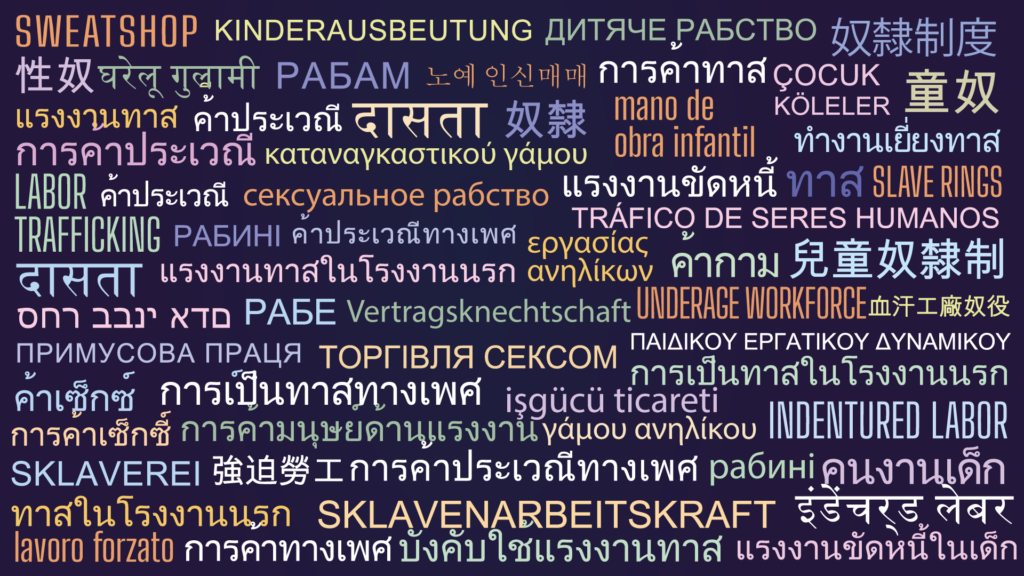In a globalised business environment, ensuring ethical practices across supply chains is paramount. Furthermore, the EU Corporate Sustainability Due Diligence Directive (CS3D) requires obliged entities to identify, prevent, mitigate, and end negative impacts on human rights and the environment in their value chain, or face the financial consequences. One of the most egregious violations of ethics is the persistence of modern slavery, a term that encompasses a variety of human rights abuses, including forced labour, human trafficking, and child labour. It is estimated that over 40 million people worldwide are victims of modern slavery, highlighting the critical need for businesses to scrutinise their suppliers for such practices.
However, due to cultural, geographical, and linguistic variations, modern slavery is often hidden behind different words, phrases, and languages. This linguistic complexity poses a significant challenge for businesses conducting supplier due diligence through adverse media screening. This is where multilingual Natural Language Processing (NLP) comes in.

Multilingual NLP: overcoming language barriers
Modern slavery is articulated differently across languages and regions. For instance, the term ‘forced labour’ might be referred to as ‘trabajo forzado’ in Spanish, ‘travail forcé’ in French, or ‘強制勞動’ in Chinese. Furthermore, colloquialisms, euphemisms, and regional idioms may be used to describe conditions of modern slavery.
In some regions, terms like ‘bonded labour’, ‘debt bondage’, ‘human trafficking’, or ‘child labour’ are common. In others, less formal or indirect expressions may be used to describe exploitative situations that amount to modern slavery.
In this context, multilingual NLP’s ability to understand, analyse, and interpret nuances across languages is invaluable. It can bridge linguistic gaps, ensuring that no adverse media linked to modern slavery slips through the cracks due to language barriers.
For instance, multilingual NLP can be trained to recognise and understand different terms, phrases, and idioms that indicate modern slavery in different languages and contexts.
Multilingual sentiment analysis, a component of NLP, is particularly useful in this regard. It can assess the sentiment of content across different languages, helping to identify negative contexts or implications linked to suppliers. It can interpret subtle cues in language that may allude to modern slavery, such as exploitative working conditions, inadequate wages, or violation of labour laws.
Furthermore, machine translation, another capability of multilingual NLP, can translate adverse media content from different languages into a language that the organisation can understand. This both ensures that no critical information is lost due to language barriers, and allows for the comparative analysis of suppliers across different regions and markets.
However, the complexity of language means that multilingual NLP systems need to be trained on diverse and representative datasets to perform effectively. This training should encompass the multitude of ways modern slavery can be expressed in different languages, regions, and cultures. It should also account for the context in which terms and phrases are used, as the same term can imply different things in different contexts.
Conclusion
By leveraging multilingual NLP, businesses can perform more comprehensive and accurate adverse media screening, aiding in more robust supplier due diligence. This not only helps businesses avoid reputational risk and regulatory penalties but also contributes to the global fight against modern slavery.
The task of identifying and understanding the myriad ways in which modern slavery can be expressed in different languages and contexts is no small feat. However, with the aid of multilingual NLP, businesses can unearth these hidden linguistic nuances, contributing significantly to a more accurate and comprehensive supplier due diligence process. By doing so, they can ensure that their supply chains are not only profitable but also ethical and socially responsible.
Our latest product, smartEYE, is a software application that watches your third-party relationships, 24/7, to identify emerging ESG or adverse media risks throughout the relationship. To learn more about how smartEYE can protect your organisation from third-party risk by association and preserve your brand integrity, sign up to our mailing list.